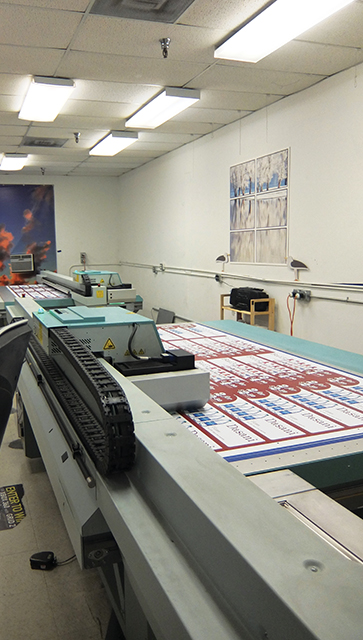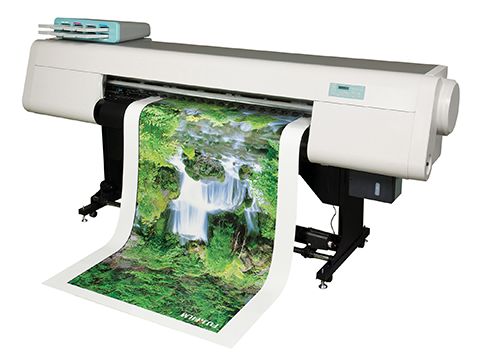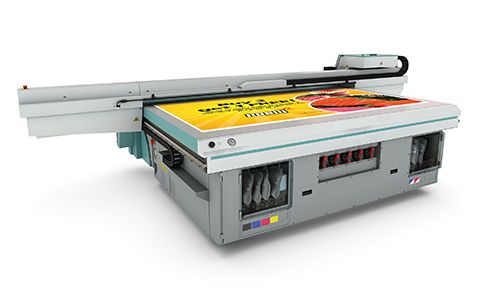Wide-format Graphics: When to buy a flatbed printer
by all | 26 May 2015 1:55 pm
 [1]
[1]Photos courtesy Fujifilm North America
By Peter Saunders
Flatbed inkjet printing systems have become a very popular and useful tool for graphics producers. According to document technology strategy and consulting firm InfoTrends, the retail value of wide-format graphics has experienced a compound annual growth rate (CAGR) of 7.5 per cent in North America over the past five years, reaching an estimated $20.5 billion U.S. in 2015. Signs and other wide-format graphics remain an integral part of major marketing campaigns, representing a major opportunity for print service providers (PSPs).
The rise of wide-format printing has been particularly impressive in comparison to the commercial offset printing sector. When North American wide-format businesses grew by an average of 10.4 per cent in 2011 over 2010, commercial offset businesses shrank by 0.5 per cent. Not coincidentally, many offset printing companies have begun to add wide-format digital inkjet printers to their production departments in recent years.
The shrinking market for some traditionally offset-printed applications is not the only reason for this trend, however. Offset PSPs are also attracted to the higher profit margins that can be realized with wide-format graphics, from flexible banners, wall murals and floor graphics to rigid point-of-purchase (POP) displays, fine art reproductions and trade show exhibits.
“They may also seek to ‘build a fence’ around their existing client base by adding capabilities to meet more of their customers’ marketing needs, like end caps for store aisles and backlit prints for restaurants’ menu boards, rather than force them to shop elsewhere,” says Heather Roden, associate product marketing manager for Fujifilm North America’s graphic systems division. “And compared to screenprinting, setup time is minimal, short runs are economically feasible and customization can become highly personalized.”
That said, it may not always be clear when a sign shop or PSP is ready to make a significant capital investment in a flatbed system, let alone what to look for to ensure the best equipment purchasing decision is made for the needs of that particular business.
Winning more work
One issue is determining the right tool for the job. Different kinds of equipment lend themselves to achieving different kinds of applications.
Roll-to-roll inkjet printers, for example, offer many of the same digital advantages as flatbeds and can print a broad variety of wraps, banners and other flexible graphics, using paper, vinyl or lightweight textiles, but they cannot by their nature print on rigid media. So, while many PSPs and sign shops first dip their toe into digital wide-format graphics with a roll-to-roll model, it is often just a stepping stone. As soon as they are called upon to print on materials like foamboards, rigid polyvinyl chloride (PVC) panels and aluminum composites—or unusual substrates like glass, wood, carpets, metals and magnetic materials—they will need either a ‘true’ flatbed press or at least a ‘hybrid’ printer.
(By way of explanation, with a hybrid flatbed printer, the printing carriage is stationary and the substrate passes through it, from a feed table to a take-up table. With a true flatbed printer, on the other hand, a vacuum table keeps the substrate stationary, while the inkjet printhead carriage is attached to a gantry that moves over the table.)
 [2]
[2]Many sign shops first dip their toe into digital wide-format graphics with a roll-to-roll inkjet printer.
Other flatbed-friendly applications include edge-to-edge graphics, lenticular displays, double-sided graphics, textured prints and ‘tiled’ large-scale displays involving multiple panels. All can be accomplished with perfectly repeatable registration.
Another issue is finishing. Roll-based printed graphics begin as flexible substrates, but often need to be mounted onto a rigid backer anyway. With a flatbed press, on the other hand, the same graphics can instead be directly printed onto rigid substrates, avoiding the cost and time involved in mounting them.
“With efficiency comes increased speed,” says Roden, “and with increased speed comes a better production process.”
Saving time, especially, has become increasingly important in today’s market. More and more, graphics customers have come to expect shorter turnarounds in an age of on-demand, just-in-time service. Many also order shorter runs than in the past, which has given digital an advantage over analogue printing technologies.
Serving customers better
Ultimately, the choice to purchase a flatbed printer is a question of capacity, i.e. a way to respond to an increasing number of orders from customers. As mentioned, most projects today need a quick turnaround, so when that need cannot be met, it is time to add more equipment.
“In today’s business culture, there is also a connective need for PSPs and sign shops to serve as more of a consultative advisor to their customers than in the past,” says Roden. “This presents an opportunity to show clients what they need before they need it, showcasing innovations that can be accomplished with newer flatbed printing and finishing technologies.”
The key is to still focus on the right applications. There is a lot of flexibility in digital inkjet printing that makes it possible to create many different types of products, but rather than trying to do everything, it makes more sense to do one thing very well.
Consider the example of Holland & Crosby in Mississauga, Ont. Founded in 1932 as a screenprinting shop, it established a digital department in 2004. In 2008, it became the first company to install an Inca Digital Onset flatbed printer. Its 3,066-m2 (33,000-sf) production and distribution facility could potentially output all types of graphics, but instead is highly focused on retail-based POP signage programs, from creative and structural design to prototyping and printing to finishing, storage and shipping.
 [3]
[3]Flatbed printers allow sign shops to expand into producing edge-to-edge graphics, lenticular displays and ’tiled’ graphic panels with repeatable registration.
“POP makes up 90 per cent of our work and the rest is event marketing,” explains Scott Crosby, vice-president (VP) of sales and marketing. “We stock 15 standard materials in a 1.5 x 3-m (5 x 10-ft) format. A lot of other shops straddle screenprinting and digital with different sheet sizes for each run, which can take up a lot of room and time to deal with. For us, digital was a replacement technology for screenprinting.”
Another flatbed printing company has succeeded in the U.S. by producing only real estate signs. When the owner decided to also print personalized photographic and artistic images on canvas and sell them online direct to consumers, allowing them to upload files from their computer hard drives or even Facebook and Instagram, he started an entirely different business—named Simple Canvas Prints—for that purpose, as it would require its own distinct market strategy.
Achieving potential
Today’s digital flatbed inkjet printers offer simplicity of use and the versatility to produce both flexible and rigid display graphics. They also offer the potential for profit growth, but the nature of that growth will depend on the individual approaches of the PSPs and sign shops that use them.
With files from Fujifilm North America’s graphic systems division. This article is based in part on a seminar presented by Heather Roden in April at the Specialty Graphic Imaging Association’s (SGIA’s) opportunity zone at the Graphics Canada show. For more information, visit www.fujifilm.ca[4], www.sgia.org[5] and www.graphicscanada.com[6].
|
Five ways white ink wins more business |
|
Traditional substrates for printing are white, so CMYK inks are added to areas where colour is needed. With white ink, however, almost any type of specialty media or object can become a printable substrate. The following are five ways to use white ink: 1. Spot colour 2. Primer 3. Flood 4. Centre sandwich layer 5. Multi-layer textured build Heather Roden is associate product marketing manager for Fujifilm North America’s graphic systems division. For more information, visit www.fujifilm.ca. |
- [Image]: http://www.signmedia.ca/wp-content/uploads/2015/05/crop1.jpg
- [Image]: http://www.signmedia.ca/wp-content/uploads/2015/05/AcuityLED1600_06.jpg
- [Image]: http://www.signmedia.ca/wp-content/uploads/2015/05/Acuity-Select-HS_FUJIFILM.jpg
- www.fujifilm.ca: http://www.fujifilm.ca
- www.sgia.org: http://www.sgia.org
- www.graphicscanada.com: http://www.graphicscanada.com
- [Image]: http://www.signmedia.ca/wp-content/uploads/2015/05/whiteink.jpg
Source URL: https://www.signmedia.ca/wide-format-graphics-when-to-buy-a-flatbed-printer/
 [7]By Heather Roden
[7]By Heather Roden